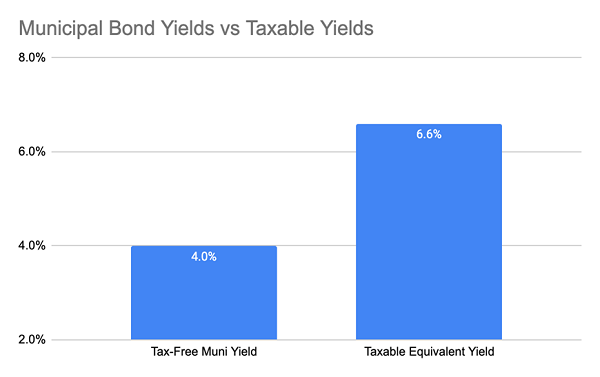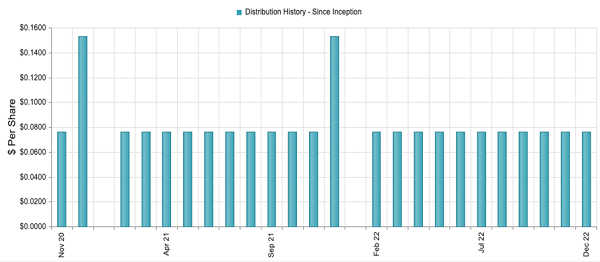3 Funds Yielding up to 9%
2022.11.28 10:49
[ad_1]
What if I told you there was a way for you to get a steady 9% dividend tax-free?
My guess is you’d be interested, especially after the tough year we’ve endured. Sure, 2023 is looking better, but no one knows what’s coming our way when it comes to inflation and rates, so more volatility is pretty much guaranteed. So a steady payout, especially sans taxes, could be the perfect fit for your portfolio.
Many investors’ response to the past year has been to go to cash. And while that may help avoid losses, it also puts you in the path of inflation running near 8%.
Truth is, most people would be better served if they went one step further and put their savings in municipal bonds. (Municipal bonds, or “munis,” are issued by state and local governments, often to fund infrastructure projects.)
Munis have fallen this year, along with everything else, but in typical muni fashion they’ve fallen less than the market. And these declines actually make them safer. (Which is saying something, given that munis already have microscopic default rates—in the 0.01% range).
In fact, I expect strong income and upside from munis in 2023. The reason why lies in a recent Pew Research study showing that state tax-revenue growth is now ahead of pre-pandemic levels. That’s because unemployment is low, and many workers have gotten raises, so they’re paying more income tax. Inflation is also boosting sales-tax revenues.
Municipal Incomes Secured

State Tax Revenue Rebounds
Then there’s the fact that the income munis pay is tax-exempt for most Americans, which is no small thing. For those in the highest tax bracket, a 4% muni yield equals 6.6% on a taxable basis. Good luck getting that from stocks!

Muni Bond Yields
Source: CEF Insider
Below are three funds that can get you a healthy muni-bond income stream, starting with the popular muni-bond ETF.
1. This ETF Is Most People’s Intro to the Muni World
Most municipal-bond investors start with the iShares National Muni Bond ETF (NYSE:), a 2%-yielding (3.3% taxable equivalent for those in the highest bracket) ETF focusing on tax-exempt municipal bonds.
But like all ETFs, MUB is tied to an index and has no active management. That may be okay for stocks, but it’s not ideal in the smaller world of munis, where we want an experienced manager who gets tipped off when states issue attractive new bonds.
Even so, if you want a no-fuss entry into munis, MUB can work. And the fund is down about 8% this year (which is a significant decline for ultra-stable munis), so you do have a nice buying opportunity here.
But my beat is CEFs, and I see the next two funds as much better ways to buy munis.
2. This Muni-Bond CEF Doubles the ETF’s Yield
The Nuveen Select Tax-Free Income Portfolio (NASDAQ:) is a CEF yielding 4% (or 6.7% on a taxable-equivalent basis for those in the highest bracket). The fund also sports a 3.2% discount to NAV, so, in effect we’re getting its portfolio of muni bonds from across the US for 95 cents on the dollar!
That’s a good deal for a fund that has nearly tripled investors’ money, with a 177% return since it was launched in the late ’90s—a solid gain for stable assets like munis. It’s also outpaced MUB (with more of its gain in the form of dividends) since the ETF was launched in 2007, with an 84% return to MUB’s 60%.
But our real opportunity lies in that 3.2% discount. As you can see below, it’s in the low end of its five-year range. And a return to last year’s premiums—likely, in my view, as investors come back to the markets (and munis, in particular, given their strong fundamentals)—would result in healthy gains.
A Wide Discount Set to Vanish

NXP Slight Discount
While we’re waiting to ride NXP’s price higher, we’ll collect its payout, which has held steady for nearly five years and looks safer than ever, backed by rising state revenues.
3. This Double-Digit Dividend ‘Masquerades’ as a 9% Payout
Finally, let’s supercharge our payouts with the 9%-yielding Nuveen Dynamic Municipal Opportunities Fund (NYSE:),whose yield tops those of all muni funds.
NDMO delivers that big dividend (equal to 11.8% on a taxable basis for those in the highest bracket) in two ways; first, it spends up to 20% of its assets buying taxable municipal bonds, which typically yield more than tax-free bonds.
With the rest, Nuveen’s team buys the most oversold municipal bonds on the market and collects the interest payments. It then hands those payouts to us as that 9% dividend.
And yes, it’s delivering that 11.8% taxable-equivalent yield despite the fact that a fifth of its portfolio is in taxable municipal bonds. That’s an incredible passive income stream. It’s also as steady as they come (and paid out monthly, too).
NDMO’s Predictable Monthly Payout

NDMO Monthly Distribution
NDMO is more volatile than MUB, for example, with a five-year beta rating of 1.3. (Beta is a measure of volatility. Funds with a beta of 1 are as volatile as the. Those above 1 are more volatile; those below 1 are less.)
However, we do get somewhat of a downside hedge in the form of the fund’s 6% discount to NAV, which is far below the 1% it’s averaged in the last five years. That makes now a good time to consider NDMO, especially in light of the incredible—and incredibly consistent—payout it offers.
Disclosure: Brett Owens and Michael Foster are contrarian income investors who look for undervalued stocks/funds across the U.S. markets. Click here to learn how to profit from their strategies in the latest report, “7 Great Dividend Growth Stocks for a Secure Retirement.”
[ad_2]







